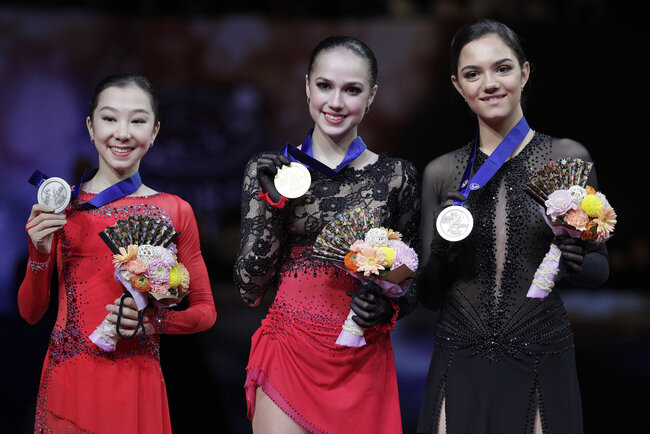Russian Troika: The 3 A's of Ladies Figure Skating
troi·ka /ˈtroikə/
noun
1. a Russian vehicle pulled by a team of three horses abreast.
The world of figure skating has been blown into new territory amid the new era of domination in the ladies’ field. Though we have seen many elite winners at the European, World and Olympic Games from the Russian Federation, there is a new tide in terms of the podium: The 3 A’s. The 3 A’s, for context, all hail from the same coach. These young women are Anna Shcherbakova, Alena Kostornaia and Alexandra Trusova, and they have owned the podiums at all major events this entire season.
All three girls won their prospective Challenger Series competitions and Grand Prix events, and they swept the podiums at the Grand Prix Final, Russian National Championships and European Championships. They have elevated the technical expectations of the sport with consistent Triple Axels or Quadruple Jumps, but are they helping or hurting the sport?
Under the tutelage of famed coach Eteri Tutberidze, the 3 A’s have dominated the Junior and Senior skating ranks over the last two seasons. Over the last two seasons, they consistently set world records and clinched countless international medals. They have combined youthful skating and technical sensation.
In a matter of seconds, Trusova broke multiple world records at the 2018 World Junior Figure Skating Championships with her iconic quadruple jumps. Shcherbakova became the first woman to land two quad lutzes at 2019 Skate America. Kostornaia currently holds records for the highest short program and highest total scores.
Coach Tutberidze’s medal count is other-worldly: She’s coached students to 5 Olympic medals (including 2 gold), 5 World medals (including 3 gold), 10 European medals, and 8 Grand Prix Final medals, all since the 2014 Olympic season. The coaching powerhouse at the Sambo-70 skating club seems to be unstoppable. However, in more recent months the skating community has found controversy stuck between the victories and progress the team has made.
Skating fans, particularly in the United States, have been debating the current state of skating: Russian domination, the progression (or regression) of the sport, and the age limit for senior competition. I spoke with Ryah Mesch, who is the Assistant Director of the Winter Village at Bryant Park, as well as a skating influencer under the name @adultskater on Instagram, to discuss her thoughts on the 3 A’s and the world of skating.
Mesch stated, “Personally, I am a big fan of Aliona because I see her as an all-around skater with a full skill set. The other two skaters I admire for their determination and strength attempting such difficult jumps and even making them look easy sometimes. However, I also feel concerned for the wellbeing of all three due to their age and level of pressure (with) such a lifestyle in the spotlight.”
Mesch’s points are common—the three girls (Shcherbakova and Trusova are 15, while Kostornaia is 16) are under immense pressure from coaches, federation, skating fans and the media. They have appeared on numerous talk shows and documentaries.
I went on to ask the John Wilson Blades Ambassador whether she felt the current state of Russian domination was helpful or harmful toward the sport.



“I feel that the Russian skaters are certainly way ahead of everyone in terms of technical difficulty, and they seem to have prodigy after prodigy with short shelf-lives. This makes it hard to really like any particular girl, because by the time they get to the top they are already on their way out. The worst thing, as a spectator, is to see your favorite skater retire too soon and suddenly a new girl has replaced them. For young skaters and fans, seeing this leads you to feeling like you can’t compete, or that if you did it would be short-lived and pointless.” In 2013, the podium at the World Championships saw the three medalists, Yu-Na Kim (22), Carolina Kostner (26), and Mao Asada (22) sit atop the world podium. In just seven years, we have seen the age of top skaters drop by nearly as many years.
Ryah discussed her views on the age minimum in skating, a highly debated issue that was brought up at the ISU council after the 2018 Olympics. Currently, the minimum age to compete at Senior international events (the highest level) is 15 years old.
“I do feel that the age should be raised, because the goal would be to extend the careers of beautiful skaters who otherwise would have retired sooner. Doing this (in my opinion) would allow for longer skating careers, which would make fans and skaters happier to participate in the sport.”
Though it is an issue discussed commonly in American circles, Russian skating has greater public interest and event turnout, making the Russian domination and concerns for age a greater issue than they seem. The U.S. has not lost all hope, though. Our recent two-time national champion, Alysa Liu, has joined the Junior ranks with triple axels and a quad lutz.
We will have to wait until next season to see whether she can maintain her junior success on the senior ranks, but until then, with the World Championships coming on March 16th, the Russian domination of the 3 A’s is far from finished.



